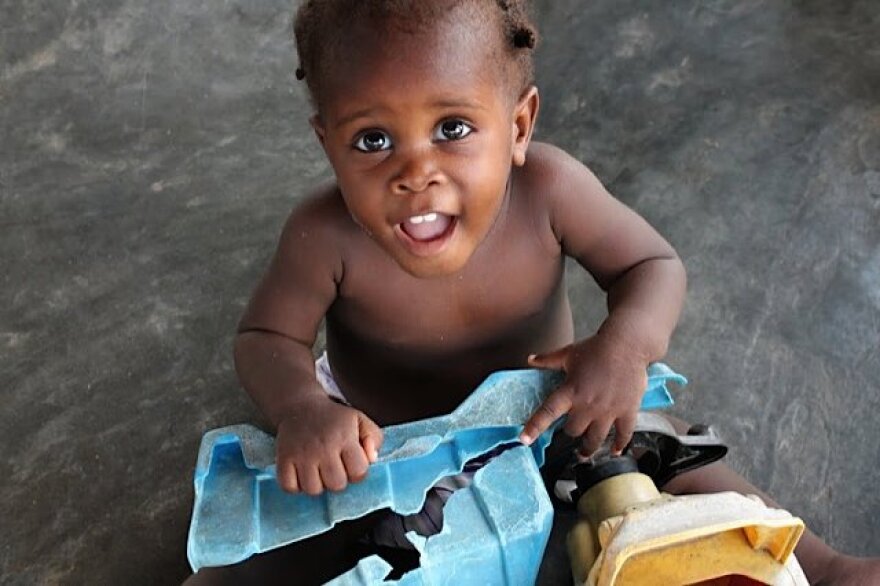Esther Savage loves a lot of things. She loves practicing her cartwheels. She loves light saber duels with her mom – and tickle fights. Her giddy laughter is infectious. And like many 5-year-olds, she loves singing along to "Frozen."
Just a few years ago, though, Esther wasn’t singing or saying anything.
“She was a healthy, normal baby girl, and she was not hearing. She didn’t hear anything. She had no sound at all,” said Tiffany Savage, who adopted Esther in 2012.
Esther was just a toddler in an orphanage in Haiti. Savage said when Esther was about 16 months old, she contracted severe meningitis, which damaged the hair follicles in her inner ear.
“She lived through the process but completely lost her hearing,” Savage said. “So she went from the orphanage to the hospital, came back home deaf, and then from that point until we picked her up, nobody realized she wasn’t hearing anything.”

For eight months, Esther’s world was silent. She couldn’t communicate, and her hearing loss went neglected. The Savages found her a doctor immediately after they brought her home from Haiti – and after extensive research, decided to give Esther cochlear implants.
“When we turned it on, it wasn’t like the magical ‘turn on’ experience that you see on YouTube of ‘here’s my mom’s voice for the first time; I’m excited,’” Savage said. “It was scary to her because she hadn’t had sound in a while. But the good thing for her is that she had had sound. So quickly – I would say within a week or less than a week – she was excited.”
Since 2012, about 38,000 hearing aid devices have been implanted in children.
Jennifer Lake is an audiologist with Cochlear Americas, the company that developed the technology. She said catching hearing loss in toddlers like Esther can be tricky – because it can be hard to tell if little kids are actually having trouble communicating or simply learning the fundamentals of speech. But there are detectable signs.
“You start to see the babbling go away because they don’t have any way of monitoring their own voice,” Lake said. “[Esther] probably wasn’t turning to her name. She probably wasn’t looking around. She wasn’t alerting to sounds, and wasn’t being able to hear things from behind her. So she would basically be within herself.”
That’s where the cochlear implant comes in. It turns sounds into electrical pulses that the brain can decode.
However, Lake said hearing is only one part of communication.
“Just because you get the cochlear implant, doesn’t mean the work is done," Lake said. "There’s a lot that goes into the success of a child between the parents as well as their support groups and also the auditory-verbal therapy."
And being able to hear and develop communication skills is important for kids in more ways than one. The American Speech-Language-Hearing Association says children with severe to profound hearing loss usually achieve skills no higher than the third or fourth grade – unless teachers and parents intervene early. And the gap in academic achievement can widen as they progress through school, leading to feelings of isolation and lower self-esteem.
“When you can’t communicate your wants and needs, especially as a child when that’s the main form of becoming a person, I feel like that would be very frustrating,” said Allyson Ochsner, a deaf education teacher at Davis Elementary in Plano.
Ochsner is Esther Savage’s kindergarten teacher this year, and she was also her teacher at Pearson Early Childhood School. Both schools are part of a deaf education system in Collin County – which starts at Pearson, feeds into Davis and then on to Haggard Middle School, Vines High School and Plano Senior High School.
Ochsner says teaching hearing-impaired kids is all about the basics.
“We rely a lot in our early education on incidental learning. So you learn when your mom is touching something that it’s hot, and you learn that by watching her and hearing her say that it’s hot,” Ochsner said. “And so I think that children who experience hearing loss at such a young age are missing out on so much incidental learning from just hearing what’s going on around in their environment.”

Ochsner’s lesson plans try to recreate that incidental learning. She labels everything, uses sign language as well as verbal communication to ingrain the sounds and meanings. She narrates actions, and is constantly asking her students what they want and need.
“We always hear as teachers [from parents], ‘we just want our kids to be normal. We want them to be like their friends.’ And it’s like, we would love that too. We want them to be on track with their peers,” Ochsner said.
She said it’s hard to believe that Esther’s hearing loss went untreated for eight months. It’s only her second week of kindergarten, and she’s already stringing together complex 10-word sentences – and even using past tense. Ochsner has no doubt Esther will be moving on to regular classes soon – with her cochlear implants, and of course, lots of help from mom, Tiffany Savage.
“She is just such a bright kid. Everybody just loves her. She lights up a room; she never meets a stranger,” Savage said. “Just a sweet, sweet spirited kid.”
Savage said it’s that spirit that will be the key to Esther’s success – in spite of everything she's been through.





